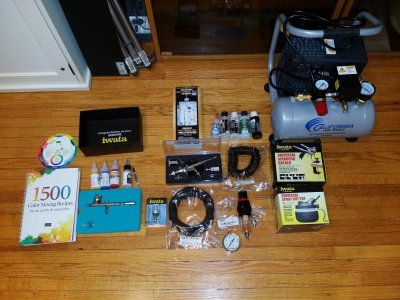Ok, thanks JackEB. I did contact Spraygunner and describe the symptoms and they didn't really question it so I think my instinct is correct but if you don't mind checking too and posting what you find that would be great. If I'm wrong that would give me time to contact them first thing in (my) morning before they ship another one out. It's hard for me to imagine that it's correct as-is but you never know.
On a related note I can no longer say that I've never used an airbrush!
I grabbed a piece of spare glass, drew up some practice patterns to go behind it like in Seamonkey's video, and gave it a shot tonight. I learned a few things:
1) I was able to hit the glass.
2) Ok, I could actually hit sort of where I was aiming. Worked on lines, filling in defined areas, drawing spheres and such.
3) I am initially finding the PS-290 easier to use than the HP-CS. I think that's primarily because the pistol trigger is more instinctive to me. I tried the CS first, then the 290, and then tried the CS again. The CS was easier the second time but my brain to finger connection is still clearly operating in serial mode rather than parallel mode with it.
4) The 290 definitely goes through paint faster than the CS, especially with the fan tip. No surprise I guess but it does go to the points that have been raised previously about potentially using a detail spray gun for larger areas so as not to have to continually refill.
5) I have no idea how anyone makes fine lines. The best I could do in one pass was maybe 2 mm even at very low spraying pressures. Maybe the glass/hard surface isn't helping in that regard because even 5-10 psi I was seeing spidering if I got too close or pulled the trigger too much, and the "lines" were not very dark at all.
6) The Com-Art paint sprays just fine right out of the bottle (at least to my inexperienced eyes). If that will work for my models that may be the easy way to go.
7) I also tried some Createx transparent black, thinned approximately 3:1 (thinner

aint) per what Seamonkey mentioned in his video. It worked, no problems with clogging, but it didn't seem to lay down quite as nicely and, oddly, it was tougher to scrape off of the glass when it came time to "erase". As you've all said, looks like it would take a bit more experimentation to optimize things.
Anyway, the journey has begun, thanks to all again for the ongoing help and encouragement!

